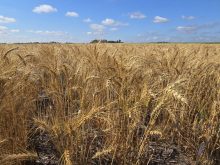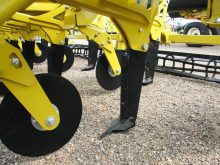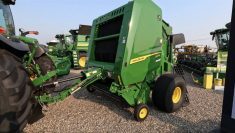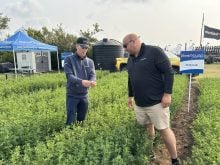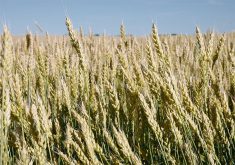Seeding winter cereals “ultra early” in the spring can hedge against drought by offering an alternative feed source, according to Alberta research results.
The project’s origins can be traced to the extremely dry year of 2021, which left many Lakeland area producers in need of feed and water resources. Canola crops withered, yielding as little as 30 per cent of normal, and overgrazed pastures produced less in the following year.
Many livestock producers turned to novel feeds and grazing annuals in 2021 when drought withered pastures and normal forage sources failed to produce.
Read Also

Fertilizer method’s link to emissions studied
A researcher says others studying greenhouse gas emissions aren’t considering how the loss of nitrogen into the atmosphere correlates with fertilizer application or if there is an impact to yield.
Winter cereals sown in fall have proven their value in providing early-season grazing in spring. However, that comes with a catch: the crops move into reproductive stage relatively soon, so quality and production decline beyond July.
Early spring-seeded winter cereals remain in the vegetative stage throughout the summer and fall, improving biomass, maintaining nutritional quality and creating more chances for grazing, wrote Alyssa Krawchuk, of the Lakeland Agricultural Research Association (LARA), in an email.
These grazing opportunities can begin in early June and extend into September.
More grazing periods in a growing season is just the start. An additional harvest opportunity and forage quality improvement were two more highlights of the early-seeding approach.
Early seeding also resulted in greater biomass production, which Krawchuk said could make or break an operation during dry or drought conditions when feed sources are scarce. Having that extra biomass can give perennial pastures the chance to rest and regenerate, reducing the need for producers to buy dry feed or rent other pastures.
“The year after a drought, this could be used as a method to defer grazing on drought-stressed pastures until later in the grazing season and provide more rest for these pastures throughout the summer.”
Early winter wheat seeding also seems to increase crude protein levels in feed compared to regularly-timed counterparts. The tactic can create more grazing days and reduce production costs while maintaining adequate feed quality and quantity.
“Furthermore, by seeding early, the winter cereals can take advantage of any early growing season moisture that might occur before regular seeding dates,” said Krawchuk.
“In addition, seeding cereals early in the spring allows for capture of early season moisture through snow melt that may not be available in dry and drought conditions later in May when cereals are normally seeded.”
The research project took place at the LARA Fort Kent research site in the Municipal District of Bonnyville. The “ultra-early” seeding date was April 29, 2022, in a soil temperature of 2 C. The regular seeding date was May 27, 2022, more or less within the normal seeding schedule for the region, in a 12 C soil temperature.
Wheat was harvested when each variety was an average of 30 centimetres high and cut to two inches. Regrowth was harvested throughout the summer and fall once it reached 30 cm.
Due to dry soil conditions at the time, varieties of winter cereals were planted to a depth of 1.5 inches. Six treatments included two varieties of winter triticale (Metzger and Luoma) and two each of winter wheat (Pintale and Wildfire) and fall rye (Prima and Hazlet). Plots were 1.15 metres wide by 7.5 metres long with a minimum harvested area of six square metres.
There was little difference in first harvest timing between the two treatments. Both were between seven and eight weeks after planting. Early-seeded regrowth was harvested in three weeks. The third harvest occurred seven weeks later, with regular-seeded regrowth harvested seven weeks after the first harvest.
The early-seeded treatment produced more total yield than the regular-seeded treatment. Hazlet fall rye and Luoma winter triticale were the top-yielding varieties. The former produced about 0.67 tonnes per acre of dry matter forage yield whether seeded in the early and regular categories.
The lowest-yielding cereal was Metzger winter triticale with about 0.32 tonnes per acre of forage yield with the early-seeded treatment and just a little higher with the regularly timed seeding.
Although there was some difference in crude protein among varieties, the early-seeded cereals sported higher crude protein and the first harvest had higher crude protein than the subsequent harvest.
Wildfire winter wheat, for example, produced 28.25 per cent crude protein in the early-seeded set while the same variety scored 24.74 per cent with the regularly-seeded treatment.
The number of total digestible nutrients was much higher in the first harvest than those thereafter. However, they did not differ by variety or seeding date.
There are risks to planting cereals so early, but they may not be the ones producers first think of, said Krawchuk.
“Frost tends to be the number one question when proposing early-seeded cereals to local producers. However, cereal crops have been shown to withstand temperatures as low as -8 for a short period without detrimental impacts on growth and productivity.”
A bigger challenge when seeding winter cereals in low soil temperatures is the capacity of fields to hold the weight of seeding equipment.
“This is heavily dependent on soil type and moisture, which tends to be more of an issue the further north you go in Alberta where more clay type soils dominate.”
Although the 2022 project was intended to develop guidance for cereal producers in northeastern Alberta, LARA plans to take this show on the road. With new funding from Results Driven Agriculture Research hopefully in hand, Krawchuk and her team plan to expand the trial to Oyen, Fairview and Fort Vermilion.
“We feel it is imperative to run this trial in different eco-regions of the province as varying agroclimatic conditions will have an impact on the biomass produced and the number of harvests achieved.”
The basic concept of the pending projects will remain the same but with some differences.
“The trial now includes three varieties of each winter wheat, winter triticale and fall rye and will be compared to an annual cereal commonly grown for feed. In addition, we will be working with economist Kathy Larson from the University of Saskatchewan to provide producers with a cost-benefit analysis for the project.”
LARA is a non-profit, producer-driven, grassroots research and extension organization operating in the Lakeland region of Alberta since 1991.






